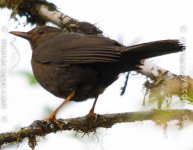George Edwards
Nom de plume
Is this likely to be a female Glossy-black Thrush? It was taken at San Isidro, March, in a hedgerow. The only possibilities there are:
Pale-eyed Thrush - common resident.
Great Thrush - very common resident.
Glossy-black Thrush - common resident.
Chestnut-bellied Thrush - uncommon to fairly common resident.
Black-billed Thrush - uncommon visitor.
The (young) guide was not sure because it doesn't have the yellow eye-ring a female Glossy-black Thrush should have (eg http://www.pbase.com/ahlman/image/128116006/original), and yet to him didn't look like a Great Thrush either (http://birdway.com.au/turdidae/great_thrush/source/great_thrush_25043.htm).
Pale-eyed Thrush - common resident.
Great Thrush - very common resident.
Glossy-black Thrush - common resident.
Chestnut-bellied Thrush - uncommon to fairly common resident.
Black-billed Thrush - uncommon visitor.
The (young) guide was not sure because it doesn't have the yellow eye-ring a female Glossy-black Thrush should have (eg http://www.pbase.com/ahlman/image/128116006/original), and yet to him didn't look like a Great Thrush either (http://birdway.com.au/turdidae/great_thrush/source/great_thrush_25043.htm).





